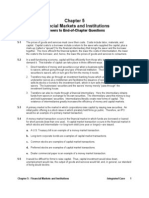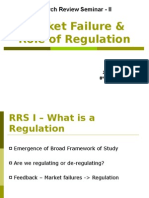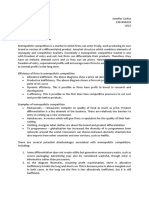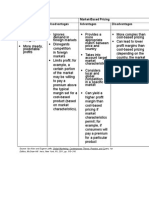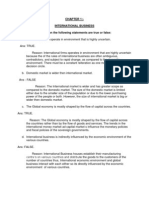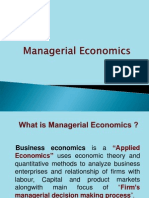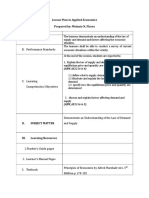Chapter 5 - Competitors and Competition
Chapter 5 - Competitors and Competition
Uploaded by
Mia SentosaCopyright:
Available Formats
Chapter 5 - Competitors and Competition
Chapter 5 - Competitors and Competition
Uploaded by
Mia SentosaCopyright
Available Formats
Share this document
Did you find this document useful?
Is this content inappropriate?
Copyright:
Available Formats
Chapter 5 - Competitors and Competition
Chapter 5 - Competitors and Competition
Uploaded by
Mia SentosaCopyright:
Available Formats
Economics of Strategy
Fifth Edition
Slides by: Richard Ponarul, California State University, Chico
Copyright 2010 John Wiley Sons, Inc.
Chapter 8
Competitors and Competition
Besanko, Dranove, Shanley, and Schaefer
Competition
If one firms strategic choice adversely
affects the performance of another they are
competitors
A firm may have competitors in several
input markets and output markets at the
same time
Competition can be either direct or indirect
Direct and Indirect Competitors
Direct competitors: Strategic choice of one
firm directly affects the performance of the
other
Indirect competitors: Strategic choice of one
firm affects the performance of the other
because of a strategic reaction by a third
firm
Identifying Competitors
DOJ Guideline: Merger with all the
competitors should lead to a small but
significant non-transitory increase in price
(SSNIP)
Small: At east 5%
Non-transitory: At least for one year
Identifying Competitors
In practice any one who produces a
substitute product is a competitor
Two products tend to be close substitutes
when
they have similar performance characteristics
they have similar occasion for use and
they are sold in the same geographic area
Performance Characteristics
Performance characteristics describe what
the product does to the customer
Example from automobiles
Seating capacity
Curb appeal
Power and handling
Reliability
Occasion for Use
Products may share characteristics but may
differ in the way they are used
Orange juice and cola are beverages but used
in different occasions
Another example: Hiking shoes versus court
shoes
Geographic Area
Identical products in two different
geographic markets will not be substitutes
due to transportation costs
Bulky products like cement cannot be
transported over long distances to benefit
from geographic price difference
Empirical Approaches to Competitor Identification
Cross price elasticity of demand
Pattern of price changes over time
Firms in the same Standard Industrial
Classification (SIC)
Cross Price Elasticity
x x
y y
yx
P P
Q Q
/
/
If
yx
is positive, consumers
purchase more of Y when the
price of X increases
Patterns in Price Changes
Prices of close competitors tend to be highly
correlated
Data on purchase patterns reveal how
individual consumers react when sellers
change their prices
Standard Industrial Classification (SIC)
Products and services are identified by a
seven digit code
Each digit represents a finer degree of
classification
Products that belong to the same genre or
the same SIC need not be substitutes
Geographic Competitor Identification
When a firm sells in different geographical
areas, it is important to be able identify the
competitor in each area
Rather than rely on geographical
demarcations, the firm should look at the
flow of goods and services across geographic
regions
Identifying Competitors in the Area
Step 1: Locate the catchment area. (where
the customers come from)
Step 2: Find out where the residents of the
catchment area shop
With some products like books and drugs
being sold over the internet identifying
geographic competition becomes more
difficult
Market Structure
Markets are often described by the degree of
concentration
Monopoly is one extreme with the highest
concentration - one seller
Perfect competition is the other extreme
with innumerable sellers
Measures of Market Structure
The N-firm concentration ratio
(the combined market share of the largest N
firms)
Herfindahl index (the sum of squared
market shares)
When the relative size of the largest firms is
important Herfindahl is likely to be more
informative
Four Classes of Market Structure
Nature of
Competition
Range of
Herfindahls
Intensity of Price
Competition
Perfect
Competition
Usually < 0.2 Fierce
Monopolistic
Competition
Usually < 0.2 Depends on the degree
of product differentiation
Oligopoly 0.2 to 0.6 Depends on inter-firm
rivalry
Monopoly > 0.6 Light unless there is
threat of entry
Perfect Competition
Many sellers who sell a homogenous good
Many well informed buyers
Consumers can costlessly shop around
Sellers can enter and exit costlessly
Each firm faces infinitely elastic demand
Zero Profit Condition
With perfect competition economic profits
go to zero
When profits are maximized percentage
contribution margin or PCM = 1/ where
is the elasticity of demand
In perfect competition is infinity and
hence PCM = 0
Conditions for Fierce Price Competition
Even if the ideal conditions are not present,
price competition can be fierce when two or
more of the following conditions are met.
There are many sellers
Customers perceive the product to be
homogenous
There is excess capacity
Many Sellers
Even when the industry is profitable, a low
cost producer may prefer to set a low price
With many sellers, cartels and collusive
agreements harder to create and sustain
Small players will be tempted to cheat and
small cheaters may go undetected
Homogeneous Products
Three sources of increased revenue when
price is lowered
Customers buying more
New customers buying
Customers switching from the competitors
Homogenous Products
For firms that cut prices, customers
switching from a competitor are likely to
be the largest source of revenue gain
Customers will be less loyal to the sellers
and sellers are more likely to compete on
price
Excess Capacity
When a firm is operating below full capacity
it can price below average cost to cover the
variable cost
If industry has excess capacity, prices fall
below average cost and some firms may
choose to exit
If exit is not an option (capacity is industry
specific) excess capacity and losses will
persist for a while
Monopoly
A monopolist faces little or no competition
in the output market
Monopolist can act in an unconstrained way
in setting prices or quality
If some fringe firms exist, their decisions do
not materially affect the monopolists profits
Monopoly
A monopolist faces a downward sloping
demand curve
Monopolist sets the price so that marginal
revenue equals marginal cost
Thus the monopolists price is above the
marginal cost and its output below the
competitive level
Monopoly and Output
The traditional anti-trust view is that limited
output and higher prices hurt the consumer.
A competing (Demsetz) view is that
consumers may benefit even at monopoly
prices if the monopoly was the result of
product innovations and efficient
manufacturing.
Monopoly and Innovation
A monopolist often succeeds in becoming
one by either producing more efficiently
than others in the industry or meeting the
consumers needs better than others
Hence, consumers may be net beneficiaries
in situations where a firm succeeds in
becoming a monopolist
Monopoly and Innovation
Monopolists are more likely to be innovative
(than firms facing perfect competition) since
they can capture some of the benefits of
successful innovation
Since consumers also benefit from these
innovations, they are hurt in the long run if
the monopolists profits are restricted
Monopolistic Competition
There are many sellers and they believe that
their actions will not materially affect their
competitors
Each seller sells a differentiated product
Unlike under perfect competition, in
monopolistic competition each firms
demand curve is downward sloping rather
than flat
Vertical and Horizontal Differentiation
Vertically differentiated products
unambiguously differ in quality
Horizontally differentiated products vary in
certain product characteristics to appeal to
different consumer groups
An important source of horizontal
differentiation is geographical location
Geography and Horizontal Differentiation
Grocery stores attract clientele based on
their location
Consumers choose the store based on
transportation costs
Transportation costs prevent switching for
small differences in price
Horizontal Differentiation
Figure 8.1: Sandwich Retailers in Linesville
Idiosyncratic Preferences
Horizontal differentiation is possible with
idiosyncratic preferences
Location and Taste are important sources of
idiosyncratic preferences
Search costs discourage switching when
prices are raised
Search Costs and Differentiation
Search cost: Cost of finding information
about alternatives
Low cost sellers try lower the search costs
(Example: Advertising)
Some markets have high search costs
(Example: Physicians)
Monopolistic Competition and Entry
Since each firms demand curve is
downward sloping, the price will be set
above marginal cost
If price exceeds average cost, the firm will
earn economic profit
Existence of economic profits will attract
new entrants until each firms economic
profit is zero
Monopolistic Competition and Entry
Even if entry does not lower prices (highly
differentiated products), new entrants will
take away market share from the
incumbents
The drop in revenue caused by entry will
reduce the economic profit
If there is price competition (products that
are not well differentiated) the erosion of
economic profit will be quicker
Monopolistic Competition and Entry
Customer loyalty allows prices to exceed
marginal cost and encourages entry
Entry considered excessive if fixed costs go
up due to entry without a reduction in prices
If entry increases variety valued by
customers, then entry cannot be considered
excessive
Oligopoly
Market has a small number of sellers
Pricing and output decisions by each firm
affects the price and output in the industry
Oligopoly models (Cournot, Bertrand) focus
on how firms react to each others moves
Cournot Duopoly
In the Cournot model each of the two firms
pick the quantities Q
1
and Q
2
to be produced
Each firm takes the other firms output as
given and chooses the output that
maximizes its profits
The price that emerges clears the market
(demand = supply)
Cournot Duopoly: An Illustration
Both firms have constant marginal cost of
$10
Demand curve: P = 100 Q
1
Q
2
Firm 1 chooses Q
1
to maximize profits taking
Q
2
as given
Reaction function: Q
1
= 45 0.5Q
2
Firm 2s problem is a mirror image of Firm
1s
Cournot Reaction Functions
Cournot Equilibrium
If the two firms are identical to begin with,
their outputs will be equal
Each firm expects its rival to choose the
Cournot equilibrium output
If one of the firms is off the equilibrium,
both firms will have to adjust their outputs
Equilibrium is the point where
adjustments will not be needed
Cournot Equilibrium
The output in Cournot equilibrium will be
less than the output under perfect
competition but greater than under joint
profit maximizing collusion
As the number of firms increases, the
output will drift towards perfect
competition and prices and profits per firm
will decline
Bertrand Duopoly
In the Bertrand model, each firm selects its
price and stands ready to sell whatever
quantity is demanded at that price
Each firm takes the price set by its rival as
a given and sets its own price to maximize
its profits
In equilibrium, each firm correctly predicts
its rivals price decision
Bertrand Reaction Functions
Bertrand Equilibrium
If the two firms are identical to begin with,
they will be setting the same price as each
other
The price will equal marginal cost (same as
perfect competition) since otherwise each
firm will have the incentive to undercut the
other
Cournot and Bertrand Compared
If the firms can adjust the output quickly,
Bertrand type competition will ensue
If the output cannot be increased quickly
(capacity decision is made ahead of actual
production) Cournot competition is the
result
In Bertrand competition two firms are
sufficient to produce the same outcome as
infinite number of firms
Bertrand Competition with Differentiation
When the products of the rival firms are
differentiated, the demand curves are
different for each firm and so are the
reaction functions
The equilibrium prices are different for each
firm and they exceed the respective marginal
costs
Bertrand Competition with Differentiation
When products are differentiated, price
cutting is not as effective a way to stealing
business
At some point (prices still above marginal
costs), reduced contribution margin from
price cuts will not be offset by increased
volume by customers switching
Market Structure: Causes
Theory would predict that the larger the
minimum efficient scale (MES) of
production the greater will be the
concentration.
If entry is not easy concentration will be the
result
Monopolistic competition would mean
easier entry and larger number of firms
Endogenous Sunk Costs
Consumer goods markets seem to have a few
large firms and many small firms
The number of large firms and the total
number of firms depend more on
advertising costs than production costs
(Sutton)
Advertising costs are endogenous sunk costs
Endogenous Sunk Costs
Early in the industrys life cycle many small
firms compete
The winners invest in their brand name
capital and grow large
The smaller firms can try to match the
investment and build their own brands or
differentiate their products and seek niches
Price-Cost Margins & Concentration
Theory would predict that price-cost
margins will be higher in industries with
greater concentration
There could be other reasons for variation in
price-cost margins
Regulation
Accounting practices
Concentration of buyers
Price-Cost Margins & Concentration
It is important to control for these
extraneous factors to study the relation
between concentration and price-cost
margin
Most studies focus on specific industries and
compare geographically distinct markets
Evidence on Concentration and Price
For several industries, prices are found to be
higher in markets with higher concentration
For locally provided services (doctors,
plumbers etc.) the entry threshold
population needed to support a given
number of sellers increases fourfold
between 1 and 2 sellers
Evidence on Concentration and Price
E
n
= entry threshold for n sellers
For locally provided services E
2
is about four
times E
1
E
3
- E
2
> E
2
E
1
E
4
E
3
= E
3
E
2
Intensity of price competition reaches the
maximum with three sellers (Bresnahan and
Reiss)
Copyright 2010 John Wiley & Sons, Inc.
All rights reserved. Reproduction or translation of this work beyond
that permitted in section 117 of the1976 United States Copyright Act
without express permission from the copyright owner is unlawful.
Requests for further information should be addressed to the
Permissions Department, John Wiley & Sons, Inc. The purchaser may
make back-up copies for his/her own use only and not for distribution
or resale. The Publisher assumes no responsibility for errors,
omissions, or damages caused by the use of these programs or from
the use of the information herein.
You might also like
- ECO162 AssignmentDocument17 pagesECO162 AssignmentALISSA ASYIKIN BINTI NORIZANI100% (7)
- Solutionsmanual Multinational Finance ButlerDocument73 pagesSolutionsmanual Multinational Finance ButlerJakob ThoriusNo ratings yet
- Economics of Strategy 5th Edition BesankoDocument8 pagesEconomics of Strategy 5th Edition BesankovikNo ratings yet
- CLP Case - Group 5Document17 pagesCLP Case - Group 5Waheed MohammedNo ratings yet
- Chapter 35 - Different Market StructuresDocument52 pagesChapter 35 - Different Market StructuresPhuong DaoNo ratings yet
- Chapter 8 - Industry AnalysisDocument54 pagesChapter 8 - Industry AnalysisMia Sentosa100% (3)
- FIM Anthony CH End Solution PDFDocument287 pagesFIM Anthony CH End Solution PDFMosarraf Rased50% (6)
- Chapter 8 - Industry AnalysisDocument54 pagesChapter 8 - Industry AnalysisMia Sentosa100% (3)
- Chapter 6 - Entry and ExitDocument53 pagesChapter 6 - Entry and ExitMia Sentosa100% (2)
- Chapter 3 The Vertical Boundaries of The FirmDocument68 pagesChapter 3 The Vertical Boundaries of The FirmRidho AnjikoNo ratings yet
- Exam 2 Guidelines 2019Document6 pagesExam 2 Guidelines 2019Sri VeludandiNo ratings yet
- ECN209 - International FinanceDocument4 pagesECN209 - International FinancehamNo ratings yet
- Chapter 6 - Entry and ExitDocument53 pagesChapter 6 - Entry and ExitMia Sentosa100% (2)
- Quiz 1 - Matematika Bisnis (2021)Document18 pagesQuiz 1 - Matematika Bisnis (2021)Andreas ChandraNo ratings yet
- Economics of Strategy: Competitors and CompetitionDocument50 pagesEconomics of Strategy: Competitors and CompetitionMacNo ratings yet
- CH 05Document14 pagesCH 05leisurelarry999No ratings yet
- Besanko SummaryDocument29 pagesBesanko SummaryJens100% (1)
- CH 07Document13 pagesCH 07leisurelarry999No ratings yet
- CH 09Document10 pagesCH 09leisurelarry999No ratings yet
- Eco-Elasticity of DD & SPDocument20 pagesEco-Elasticity of DD & SPSandhyaAravindakshanNo ratings yet
- Answers To End-Of-Chapter Questions 5Document3 pagesAnswers To End-Of-Chapter Questions 5Tommy Jing Jie NgNo ratings yet
- Book Solution Economics of Strategy Answer To Questions From The Book Also Relevant For Later Editions of The BookDocument229 pagesBook Solution Economics of Strategy Answer To Questions From The Book Also Relevant For Later Editions of The Bookvgfalcao84100% (2)
- Chapter 3Document8 pagesChapter 3Siful Islam Anik100% (1)
- Market Failure & Role of RegulationDocument38 pagesMarket Failure & Role of Regulationanand agrawalNo ratings yet
- Chapter 4 Integration and Its AlternativesDocument45 pagesChapter 4 Integration and Its AlternativesRimeh BakirNo ratings yet
- Chapter 4 - Integration and Its AlternativesDocument45 pagesChapter 4 - Integration and Its AlternativesMia Sentosa100% (2)
- 2 Real Options in Theory and PracticeDocument50 pages2 Real Options in Theory and Practicedxc12670No ratings yet
- 07 Vertical IntegrationDocument23 pages07 Vertical IntegrationThanh Nguyen100% (1)
- frm指定教材 risk management & derivativesDocument1,192 pagesfrm指定教材 risk management & derivativeszeno490No ratings yet
- Econ 121 Money and Banking: Problem Set 2 Instructor: Chao WeiDocument2 pagesEcon 121 Money and Banking: Problem Set 2 Instructor: Chao WeideogratiasNo ratings yet
- Tutorial Solution Week 2Document4 pagesTutorial Solution Week 2Arlene Lan100% (1)
- Case Analysis ofDocument14 pagesCase Analysis ofMonish Rm0% (2)
- Multinational Business Finance by Shapiro Chapter 1 SolutionsDocument10 pagesMultinational Business Finance by Shapiro Chapter 1 SolutionsEdward YangNo ratings yet
- Finance and The Multinational FirmDocument13 pagesFinance and The Multinational FirmFatin AfifaNo ratings yet
- Monopolistic and Oligopoly Competition PDFDocument28 pagesMonopolistic and Oligopoly Competition PDFJennifer CarliseNo ratings yet
- Chapter 5 Consumer BehaviourDocument5 pagesChapter 5 Consumer BehaviourZyroneGlennJeraoSayanaNo ratings yet
- Cost Based and Market Based PricingDocument1 pageCost Based and Market Based PricingkabansalNo ratings yet
- Chapter 1 - The Power of Principles An Historical PersperctiveDocument26 pagesChapter 1 - The Power of Principles An Historical PersperctiveMia SentosaNo ratings yet
- Chapter 29 M&ADocument26 pagesChapter 29 M&Asinagadian67% (3)
- Gruber3e Ch05Document34 pagesGruber3e Ch05Assfaw KebedeNo ratings yet
- Unit 8 MonopolyDocument24 pagesUnit 8 MonopolyRanjeet KumarNo ratings yet
- Bear Stearns and The Seeds of Its DemiseDocument15 pagesBear Stearns and The Seeds of Its DemiseJaja JANo ratings yet
- Case Study in The International Marketing CourseDocument3 pagesCase Study in The International Marketing CourseMaureen Grace PacaldoNo ratings yet
- Exposure and Risk in International FinanceDocument24 pagesExposure and Risk in International Financemanojpatel51100% (6)
- Porter's Five Forces Model - Analysing Industry Structure PDFDocument9 pagesPorter's Five Forces Model - Analysing Industry Structure PDFAniketKulkarniNo ratings yet
- Chapter 15-16 Effective Teams and CommunicationDocument75 pagesChapter 15-16 Effective Teams and CommunicationHaryadi WidodoNo ratings yet
- Real Business Cycle TheoryDocument32 pagesReal Business Cycle Theoryrajan20202000No ratings yet
- The World Bank, Multinational Companies and The Resource Curse in Africa.Document67 pagesThe World Bank, Multinational Companies and The Resource Curse in Africa.Oreoluwa AsanmoNo ratings yet
- Elasticity EconomicsDocument14 pagesElasticity EconomicsYiwen LiuNo ratings yet
- 1.5.monopolistic CompetitionDocument13 pages1.5.monopolistic CompetitionManhin Bryan KoNo ratings yet
- Notes of Intl - BizDocument262 pagesNotes of Intl - BizPooja AnamNo ratings yet
- Porters 5 Forces AnalysisDocument6 pagesPorters 5 Forces AnalysisRobi MatiNo ratings yet
- Week 6 QuestionsDocument10 pagesWeek 6 QuestionsChandan BcNo ratings yet
- Case - Studies - in - Finance - Managing - For - Cor 3Document8 pagesCase - Studies - in - Finance - Managing - For - Cor 3Taylor StephensNo ratings yet
- Economics of Strategy (Rješenja)Document227 pagesEconomics of Strategy (Rješenja)Antonio Hrvoje ŽupićNo ratings yet
- Energy IndustryDocument28 pagesEnergy IndustrySeong-uk KimNo ratings yet
- BIF Capital StructureDocument13 pagesBIF Capital Structuresagar_funkNo ratings yet
- International Business: by Charles W.L. HillDocument39 pagesInternational Business: by Charles W.L. HillBabar HassanNo ratings yet
- Financial Instruments and Institutions: Accounting and Disclosure RulesFrom EverandFinancial Instruments and Institutions: Accounting and Disclosure RulesNo ratings yet
- Economic Indicators for Eastern Asia: Input–Output TablesFrom EverandEconomic Indicators for Eastern Asia: Input–Output TablesNo ratings yet
- Chapter 4 - Integration and Its AlternativesDocument45 pagesChapter 4 - Integration and Its AlternativesMia Sentosa100% (2)
- Chapter 1 - The Power of Principles An Historical PersperctiveDocument26 pagesChapter 1 - The Power of Principles An Historical PersperctiveMia SentosaNo ratings yet
- L09 OligopolyDocument45 pagesL09 OligopolyRick DiazNo ratings yet
- ECN 306 - Marginalists SchoolDocument16 pagesECN 306 - Marginalists SchoolAbbieNo ratings yet
- Economic - Paper 02Document5 pagesEconomic - Paper 02Sanduni WijewardaneNo ratings yet
- Disequilibrium in Balance of PaymentsDocument83 pagesDisequilibrium in Balance of PaymentsBhavik Thaker100% (1)
- Lesson Two (SC)Document12 pagesLesson Two (SC)zuhuurapdi123No ratings yet
- Rent Control Act - SatvikDocument100 pagesRent Control Act - Satvikjeevan.shanware2214No ratings yet
- ECON1210 24s Tutorial 7 Notes (Donald)Document31 pagesECON1210 24s Tutorial 7 Notes (Donald)mervyn2200No ratings yet
- Kerger PDFDocument36 pagesKerger PDFJorge ArrietaNo ratings yet
- Market EquilibriumDocument36 pagesMarket EquilibriumLiraOhNo ratings yet
- CH28 練習解答Document4 pagesCH28 練習解答Samuel YehNo ratings yet
- Engineering Economics & Optimization: Lecture#1Document18 pagesEngineering Economics & Optimization: Lecture#1Sahab HafeezNo ratings yet
- 11 9708 13 Web 4RP Afp PDFDocument12 pages11 9708 13 Web 4RP Afp PDFckjoshua819No ratings yet
- Managerial Economics IntroductionDocument73 pagesManagerial Economics IntroductionAkshay ThaparNo ratings yet
- Microeconomics - ECO402 Solved McqsDocument47 pagesMicroeconomics - ECO402 Solved McqsEmran0% (2)
- Cee109 - Sim - Ulo 1Document39 pagesCee109 - Sim - Ulo 1Jm BayotNo ratings yet
- Economic Models.s04Document14 pagesEconomic Models.s04fionnaNo ratings yet
- Chapter 3Document25 pagesChapter 3Daniel Nugraha SNo ratings yet
- Lesson Plan in Applied Economics Semi Detailed Final PDF FreeDocument4 pagesLesson Plan in Applied Economics Semi Detailed Final PDF FreeAlbert Gevero Falsario100% (1)
- Perfectly Competitive MarketsDocument36 pagesPerfectly Competitive MarketsSaurabh SharmaNo ratings yet
- Ba Eco101 ReviewerDocument5 pagesBa Eco101 ReviewergeotrashmouthNo ratings yet
- Chapter One Economic Thought Before Adam SmithDocument130 pagesChapter One Economic Thought Before Adam SmithbopgalebelayNo ratings yet
- CIIA Syllabus Version2022 Final1Document31 pagesCIIA Syllabus Version2022 Final1Biswajit SikdarNo ratings yet
- EconomicsDocument204 pagesEconomicsandasempai100% (3)
- Man Eco NotesDocument28 pagesMan Eco NotesNicole Kate RicardoNo ratings yet
- ECS1500 AssignmentDocument4 pagesECS1500 AssignmentUnarine ThelmaNo ratings yet
- Book 1Document13 pagesBook 1董振鸿No ratings yet
- 2.2 Price Theory and Economic TheoryDocument30 pages2.2 Price Theory and Economic TheoryLeo Marbeda Feigenbaum100% (2)
- Jessore University of Science and Technology Department of Finance and Banking Syllabus For The BBA Program Effective From: 2017-2018 SessionDocument71 pagesJessore University of Science and Technology Department of Finance and Banking Syllabus For The BBA Program Effective From: 2017-2018 SessionUttam GolderNo ratings yet


















